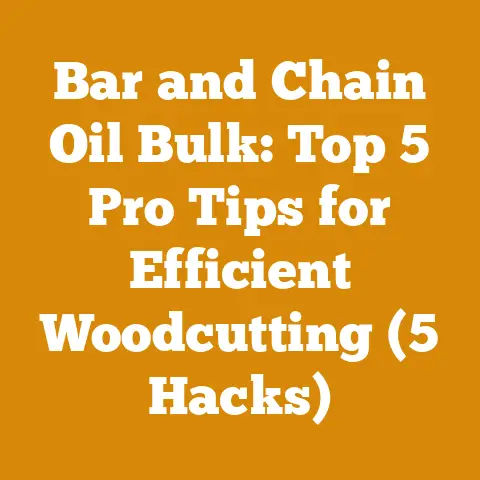Husqvarna Chainsaw Oil Cap Replacement Tips (Pro Maintenance Hacks)
Let’s get started.
Husqvarna Chainsaw Oil Cap Replacement: Pro Maintenance Hacks for Peak Performance
Replacing the oil cap on your Husqvarna chainsaw might seem like a minor task, but trust me, it’s one of those small maintenance items that can have a HUGE impact on the longevity and performance of your saw. Think of it like this: a leaky oil cap isn’t just about losing a little bar and chain oil; it’s about potential engine damage from debris entering the system, reduced lubrication leading to premature wear, and frankly, a downright messy and frustrating experience. Over the years, I’ve seen countless saws sidelined due to preventable issues stemming from something as simple as a faulty oil cap. So, let’s dive into the world of Husqvarna chainsaw oil cap replacement and arm you with the knowledge to keep your saw running smoothly.
Why Replacing Your Husqvarna Chainsaw Oil Cap Matters (More Than You Think!)
It’s easy to overlook the importance of a seemingly insignificant part like the oil cap. However, a properly functioning oil cap is crucial for several reasons:
-
Preventing Oil Leaks: This is the most obvious benefit. A tight seal prevents bar and chain oil from leaking out, ensuring consistent lubrication and preventing a sticky mess on your saw and in your workspace.
-
Protecting the Oil System: The oil reservoir isn’t just a tank; it’s a part of a delicate system. A compromised oil cap allows dirt, sawdust, and other debris to enter the oil tank, contaminating the oil and potentially damaging the oil pump and other internal components.
-
Maintaining Proper Lubrication: Inconsistent oil flow, often caused by air entering the system through a faulty cap, can lead to inadequate lubrication of the bar and chain. This, in turn, causes increased friction, heat buildup, and premature wear of these critical parts. I’ve personally experienced the frustration of a chain binding up mid-cut due to insufficient oil – a scenario easily avoidable with a good oil cap.
-
Extending Chainsaw Lifespan: By preventing contamination and ensuring proper lubrication, a functioning oil cap contributes to the overall health and longevity of your Husqvarna chainsaw. It’s a small investment that can save you significant money on repairs or replacements down the road.
Understanding Your Husqvarna Chainsaw Oil Cap
Before we get into the replacement process, let’s talk about the different types of oil caps you might encounter on your Husqvarna chainsaw. While designs can vary slightly depending on the model and year of manufacture, most Husqvarna chainsaws utilize one of two primary types:
- Screw-Type Caps: These caps feature a threaded design that screws into the oil tank opening. They are generally reliable and provide a good seal when tightened properly.
- Flip-Up (Bayonet) Caps: These caps use a bayonet-style locking mechanism. You insert the cap into the opening and then rotate it to lock it in place. They offer quick and easy access to the oil tank.
Knowing which type of cap your chainsaw uses is essential for selecting the correct replacement. I remember once trying to force a screw-type cap onto a bayonet-style opening – a rookie mistake that resulted in a damaged cap and a wasted trip to the hardware store.
Identifying a Faulty Oil Cap: Signs to Watch For
Recognizing the signs of a failing oil cap is the first step in preventing potential problems. Here are some common indicators:
-
Visible Oil Leaks: This is the most obvious sign. If you notice oil pooling around the oil cap or dripping from the chainsaw, it’s a clear indication that the cap is not sealing properly.
-
Difficulty Tightening or Loosening the Cap: If the cap feels loose or difficult to tighten, the threads may be worn or damaged. Similarly, if the cap is excessively difficult to remove, it could be a sign of deterioration or deformation.
-
Cracked or Damaged Cap: Visually inspect the cap for any cracks, chips, or other signs of damage. Even small cracks can compromise the seal.
-
Excessive Oil Consumption: If you find yourself refilling the oil tank more frequently than usual, it could be due to a slow leak caused by a faulty cap.
-
Contaminated Oil: Check the oil in the tank for dirt, sawdust, or other debris. If the oil appears dirty or cloudy, it could indicate that the cap is not providing an adequate seal.
Tools and Materials You’ll Need
Replacing your Husqvarna chainsaw oil cap is a straightforward process, but having the right tools and materials on hand will make the job easier and more efficient. Here’s what you’ll need:
- New Husqvarna Oil Cap: Purchase a replacement oil cap that is specifically designed for your chainsaw model. Refer to your owner’s manual or consult a Husqvarna dealer to ensure you get the correct part.
- Wrench or Pliers (Optional): Depending on the type of cap and how tightly it’s secured, you may need a wrench or pliers to loosen or tighten it. Use caution to avoid damaging the cap.
- Clean Rags or Paper Towels: These will be useful for cleaning up any spilled oil and wiping down the area around the oil tank opening.
- Gloves (Recommended): Wearing gloves will protect your hands from oil and grime.
- Small Screwdriver or Pick (Optional): This can be helpful for removing any debris or old gasket material from the oil tank opening.
Step-by-Step Guide to Replacing Your Husqvarna Chainsaw Oil Cap
Now, let’s get down to the nitty-gritty. Here’s a detailed, step-by-step guide to replacing your Husqvarna chainsaw oil cap:
Step 1: Safety First!
Before you begin any maintenance on your chainsaw, it’s crucial to prioritize safety.
- Turn off the Chainsaw: Ensure the chainsaw is switched off and the engine has cooled down completely.
- Disconnect the Spark Plug Wire: Disconnecting the spark plug wire prevents accidental starting of the engine.
- Wear Safety Glasses: Protect your eyes from any debris that may be dislodged during the process.
Step 2: Prepare the Work Area
Choose a well-lit and clean workspace. This will make it easier to see what you’re doing and prevent contamination of the oil system. I prefer working on a workbench covered with a clean drop cloth.
Step 3: Locate the Oil Cap
The oil cap is typically located on the side or top of the chainsaw, near the bar and chain. Refer to your owner’s manual if you’re unsure of its exact location.
Step 4: Remove the Old Oil Cap
- Screw-Type Cap: Use your hand or a wrench (if necessary) to unscrew the old oil cap. Turn it counterclockwise until it comes loose. Be prepared for a small amount of oil to spill out.
- Flip-Up (Bayonet) Cap: Rotate the cap to the unlocked position (usually indicated by arrows or markings on the cap and the chainsaw body). Then, gently pull the cap straight up and out of the opening.
Step 5: Clean the Oil Tank Opening
Use a clean rag or paper towel to wipe down the area around the oil tank opening. Remove any dirt, sawdust, or old gasket material. A small screwdriver or pick can be helpful for removing stubborn debris. This step is crucial for ensuring a good seal with the new cap. I often use a cotton swab dipped in a bit of mineral spirits to thoroughly clean the threads on screw-type openings.
Step 6: Inspect the New Oil Cap
Before installing the new oil cap, inspect it for any defects or damage. Make sure the threads are clean and the gasket (if present) is in good condition.
Step 7: Install the New Oil Cap
- Screw-Type Cap: Align the threads of the new cap with the threads of the oil tank opening. Turn the cap clockwise until it is snug. Do not overtighten, as this could damage the cap or the tank.
- Flip-Up (Bayonet) Cap: Align the cap with the opening and press it firmly into place. Then, rotate the cap to the locked position. Ensure the cap is securely locked.
Step 8: Test for Leaks
After installing the new oil cap, fill the oil tank with bar and chain oil. Carefully inspect the cap for any leaks. If you notice any leaks, remove the cap and re-inspect the threads and gasket. Reinstall the cap, ensuring it is properly tightened or locked.
Step 9: Clean Up
Wipe up any spilled oil with a clean rag or paper towel. Dispose of the old oil cap and any contaminated rags properly.
Step 10: Reconnect the Spark Plug Wire
Reconnect the spark plug wire to the spark plug.
Step 11: Test Run (Optional)
Start the chainsaw and run it briefly to ensure the oil system is functioning properly. Check for any leaks around the oil cap.
Pro Maintenance Hacks for Husqvarna Chainsaw Oil Caps
Beyond the basic replacement procedure, here are some pro maintenance hacks that can help you extend the life of your Husqvarna chainsaw oil cap and prevent future problems:
-
Use the Correct Oil: Always use high-quality bar and chain oil that is specifically designed for chainsaws. Using the wrong type of oil can damage the oil pump and other components, leading to premature wear of the oil cap and other parts. I personally prefer a synthetic blend for its superior lubrication and resistance to temperature extremes.
-
Clean the Cap Regularly: Periodically clean the oil cap and the surrounding area to remove dirt, sawdust, and other debris. This will help prevent the cap from becoming clogged or damaged. A quick wipe-down after each use can make a big difference.
-
Inspect the Gasket: If your oil cap has a gasket, inspect it regularly for cracks, tears, or other signs of damage. Replace the gasket if necessary. A worn gasket is a common cause of oil leaks.
-
Avoid Overtightening: Overtightening the oil cap can damage the threads or the cap itself. Tighten the cap until it is snug, but no tighter.
-
Store Your Chainsaw Properly: When storing your chainsaw for extended periods, empty the oil tank and clean the oil cap. This will prevent the oil from drying out and clogging the cap. I also recommend storing the chainsaw in a dry, well-ventilated area.
-
Consider a Tether: For flip-up caps, especially on saws used in demanding environments, consider adding a tether to prevent loss. I’ve seen many caps go missing in the woods! A simple piece of strong cord attached to the cap and the saw body can save you the hassle of searching for a lost cap.
-
Pay Attention to Temperature: Extreme temperature fluctuations can affect the oil cap’s seal. In very cold weather, the cap material can become brittle and more prone to cracking. In hot weather, the oil can expand and put pressure on the cap. Be mindful of these factors and adjust your maintenance accordingly.
Case Study: Preventing Oil Pump Failure with Proper Oil Cap Maintenance
I once worked with a small logging company that was experiencing frequent oil pump failures on their Husqvarna chainsaws. After investigating the issue, I discovered that the oil caps on several of the saws were cracked or damaged, allowing dirt and sawdust to enter the oil tanks. The contaminated oil was causing excessive wear on the oil pumps, leading to their premature failure.
By implementing a simple maintenance program that included regular inspection and replacement of the oil caps, as well as proper cleaning of the oil tanks, the company was able to significantly reduce the number of oil pump failures. This resulted in substantial cost savings and improved productivity. This case study highlights the importance of even seemingly minor maintenance tasks in preventing more serious and costly problems.
Troubleshooting Common Oil Cap Problems
Even with the best maintenance practices, you may occasionally encounter problems with your Husqvarna chainsaw oil cap. Here are some common issues and how to troubleshoot them:
-
Oil Cap Won’t Tighten: If the oil cap won’t tighten properly, the threads on the cap or the oil tank opening may be damaged. Inspect the threads for any signs of wear or damage. If the threads are stripped, you may need to replace the cap or, in more severe cases, the entire oil tank.
-
Oil Cap is Stuck: If the oil cap is stuck and won’t come loose, try using a wrench or pliers to gently loosen it. Be careful not to damage the cap. You can also try applying a small amount of penetrating oil to the threads to help loosen them. Let the oil soak in for a few minutes before attempting to remove the cap.
-
Oil Cap Leaks After Replacement: If the oil cap continues to leak after you’ve replaced it, double-check that you’ve installed the correct cap for your chainsaw model. Also, make sure the threads are clean and the cap is properly tightened or locked. If the leak persists, the oil tank opening may be damaged or warped.
-
Cap Feels Loose After Installation: If a bayonet-style cap feels loose after installation, ensure it’s fully rotated to the locked position. Sometimes, a small amount of debris can prevent it from fully engaging. Clean the cap and the opening and try again. If the problem persists, the locking mechanism on the cap or the tank may be worn.
The Economics of Oil Cap Maintenance: A Small Investment, Big Returns
Let’s talk numbers. A Husqvarna chainsaw oil cap typically costs between $5 and $20, depending on the model and where you purchase it. In contrast, replacing an oil pump can cost anywhere from $50 to $150, plus labor. And the cost of downtime due to a malfunctioning chainsaw can be even higher, especially if you’re running a logging operation or relying on your chainsaw for firewood production.
By investing a few dollars in a new oil cap and taking the time to perform regular maintenance, you can save yourself significant money on repairs, replacements, and downtime. It’s a simple equation: proactive maintenance = long-term savings. I’ve always believed in preventative maintenance, and oil cap care is a prime example of how a little effort can yield substantial returns.
Here are some factors to consider:
-
Model Compatibility: The most important factor is to ensure that the oil cap is compatible with your chainsaw model. Refer to your owner’s manual or consult a Husqvarna dealer to determine the correct part number. Using the wrong oil cap can result in leaks or damage to the oil system.
-
Type of Cap: As mentioned earlier, Husqvarna chainsaws typically use either screw-type or flip-up (bayonet) caps. Make sure you purchase the correct type of cap for your chainsaw.
-
Material: Oil caps are typically made of plastic or metal. Plastic caps are generally more affordable, while metal caps are more durable. Choose the material that best suits your needs and budget.
-
Quality: Opt for a high-quality oil cap from a reputable manufacturer. A cheap, poorly made oil cap may not provide a good seal and could fail prematurely.
-
Reviews: Before purchasing an oil cap, read online reviews to see what other users have to say about its performance and durability.
Safety Considerations When Working with Chainsaw Oil
Bar and chain oil can be harmful if ingested or if it comes into contact with your skin or eyes. Always follow these safety precautions when working with chainsaw oil:
-
Wear Gloves: Protect your hands from oil and grime by wearing gloves.
-
Wear Safety Glasses: Protect your eyes from splashes and spills by wearing safety glasses.
-
Avoid Contact with Skin: Avoid prolonged or repeated contact with skin. If oil comes into contact with your skin, wash it off immediately with soap and water.
-
Do Not Ingest: Do not ingest chainsaw oil. If you accidentally swallow oil, seek medical attention immediately.
-
Dispose of Oil Properly: Dispose of used chainsaw oil and contaminated rags properly. Do not pour oil down the drain or into the ground. Contact your local waste management authority for information on proper disposal methods.
-
Sharpening the Chain: A sharp chain is essential for efficient and safe cutting. Sharpen the chain regularly using a chainsaw file or a chain grinder.
-
Cleaning the Air Filter: A clean air filter ensures proper airflow to the engine. Clean the air filter regularly with soap and water or compressed air.
-
Replacing the Spark Plug: A worn spark plug can cause starting problems and reduced engine performance. Replace the spark plug annually or as needed.
-
Inspecting the Bar: Inspect the bar for wear and damage. Replace the bar if it is bent, cracked, or excessively worn.
-
Lubricating the Sprocket: Lubricate the sprocket regularly with grease.
-
Adjusting the Chain Tension: Proper chain tension is essential for safe and efficient cutting. Adjust the chain tension regularly.
-
Checking the Fuel Filter: A clogged fuel filter can cause starting problems and reduced engine performance. Check the fuel filter regularly and replace it if necessary.
-
Cleaning the Cooling Fins: Keep the cooling fins on the engine clean to prevent overheating.
By performing regular maintenance on all of these components, you can extend the life of your Husqvarna chainsaw and keep it running at peak performance.
Strategic Insights: Optimizing Your Chainsaw Operation
Beyond the tactical aspects of oil cap replacement and chainsaw maintenance, let’s consider some strategic insights for optimizing your chainsaw operation:
-
Chainsaw Selection: Choosing the right chainsaw for the job is crucial. Consider the size and type of wood you’ll be cutting, as well as the frequency of use. A larger, more powerful chainsaw may be necessary for felling large trees, while a smaller, lighter chainsaw may be sufficient for limbing and pruning. I always recommend having at least two saws: a larger one for heavy work and a smaller, more maneuverable one for detail work.
-
Wood Selection: The type of wood you’re cutting can also impact your chainsaw’s performance. Hardwoods like oak and maple require more power and can wear down the chain faster than softwoods like pine and fir. Seasoned wood is generally easier to cut than green wood.
-
Cutting Techniques: Proper cutting techniques can improve efficiency and reduce wear on your chainsaw. Use a sharp chain, maintain proper chain tension, and avoid forcing the saw. Let the saw do the work.
-
Ergonomics: Chainsaw operation can be physically demanding. Use proper lifting techniques, take frequent breaks, and wear appropriate personal protective equipment (PPE) to prevent injuries.
Next Steps: Putting Your Knowledge into Action
Now that you’ve learned about Husqvarna chainsaw oil cap replacement and pro maintenance hacks, it’s time to put your knowledge into action. Here are some practical next steps:
-
Inspect Your Oil Cap: Take a close look at the oil cap on your Husqvarna chainsaw. Is it cracked, damaged, or leaking? If so, order a replacement cap.
-
Gather Your Tools and Materials: Assemble the tools and materials you’ll need for the replacement process, including a new oil cap, a wrench or pliers (if necessary), clean rags, and gloves.
-
Follow the Step-by-Step Guide: Follow the step-by-step guide outlined in this article to replace your oil cap.
-
Implement a Maintenance Schedule: Develop a regular maintenance schedule for your Husqvarna chainsaw. Include tasks such as sharpening the chain, cleaning the air filter, and inspecting the bar.
-
Share Your Knowledge: Share your knowledge with other chainsaw users. Help them understand the importance of proper maintenance and safety.
By taking these steps, you can ensure that your Husqvarna chainsaw remains in top condition for years to come. Remember, a little maintenance goes a long way! From personal experience, I can attest that investing in proper chainsaw care not only saves you money in the long run but also makes your work safer and more enjoyable. Now, go forth and conquer those logs!
-






